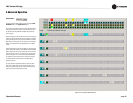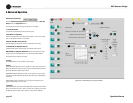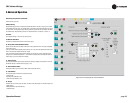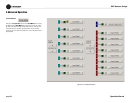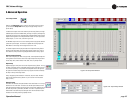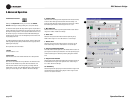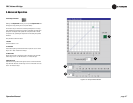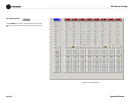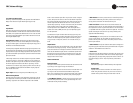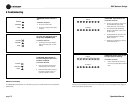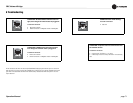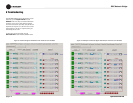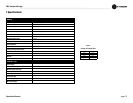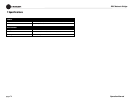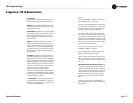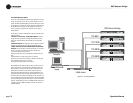
DBC Network Bridge
Operation Manual page 69
5.4 Technical Description
Following is a technical description of the operation of the DBC Network
Bridge. Please refer to the System Block Diagram (Figure 4.24).
Audio
Input Section
Each audio input signal first passes through a balanced filter designed to
eliminate RF interference. The RF filters are a balanced network of chokes,
ferrite beads, and capacitors that attenuate both common-mode and differ-
ential-mode signals above 500 kHz. Input isolation transformers are used
for the digital AES/EBU inputs.
Analog Auxiliary Inputs: The balanced signal then enters the input
switching circuit. This circuit can insert a 25dB pad for line level signals.
The signal is filtered again to eliminate lower frequency RF energy such as
interference from the AM broadcast band.
A discrete preamp stage takes the balanced input signal and provides 13 to
45 dB of voltage gain adjustable by a rear panel potentiometer. The preamp
output provides a single-ended voltage output that is then coupled to a sin-
gle-ended-to differential amplifier that also provides the bias offset needed
by the A/D converter.
A 24-bit high-resolution A/D converter samples the input audio at 48 kHz.
The audio processing is set to provide +20dBu as full scale, allowing full
utilization of the dynamic range of the converter. Each converter supplies a
two-channel digital audio stream to the DSPs for processing. One A/D
converter acts as a master to supply sampling clocks to the rest of the sys-
tem. A 12.288 MHz oscillator (256 times the 48 kHz sampling rate) acts
as the master clock source.
Digital Inputs: There’s also a digital input via DB25, analog mux.
DSP Processing Section
Four DSP processors supply all of the digital audio processing in the unit.
Serial digital audio from the input converters is sent to the DSP board for
processing. Digital audio from either the Input board or the CobraNet
board is routed to the two input DSPs. The processors collect 16 samples
of audio, then process the audio as a 'brick' of data. After the input DSPs
have processed the data, they transfer the audio bricks to shared memory.
The two output DSPs then retrieve the audio from memory and do the
required output processing. The audio is then sent serially from the DSPs
serial ports either to the monitor output or the CobraNet outputs.
The DSP processors have a 30 MHz clock, while serial digital audio is
locked to serial clock (3 MHz) and frame sync clock (48 KHz) supplied
from the Input board.
An interface to the System Controller board allows programming of the
DSPs, control updates, and metering information to be passed to the out-
side world. The DSPs depend upon the System Controller for program-
ming upon reset or initial power, as there is no nonvolatile memory on
board.
Output Section
Output serial digital audio from the DSP board is sent to the output board
for conversion and analogue processing. The serial digital audio is com-
prised of two channels of 24-bit signals. Each DAC converts the audio data
stream into two differential output channels. A differential amplifier filters
the DAC’s audio output and provides single-ended audio to a gain stage
that sets the full scale output of the DAC. A single-ended-to-differential
stage provides a 50-ohm output.
Control and Interface
System Controller
The System Controller board provides interface to the outside world as well
as providing all of the program storage and initialization.
At reset, the control processor uses boot code from nonvolatile flash mem-
ory. Program code is then transferred to fast RAM and the processor
begins to run. Each DSP processor is then booted via the system interface
and upon successful booting of all the DSPs, audio processing begins.
• Flash Memory Storage: In addition to storing program code for the
control and DSP processors, flash memory provides storage for all non-
volatile data including Presets and setting.
.
• DSP Interface: The control processor boots all of the DSP processors
via this interface. Additionally, the control processor sets all audio pro-
cessing controls and receives all meter data over this port.
• Real Time Clock: An internal real time clock allows Presets to be
called based upon a real time. The event scheduler works independently of
the computer and can recall a specific Preset either as a one-time function
or a repeatable event with a specific start time and repeat rate. The clock is
capable of retaining the correct time for up to 45 days without power
applied the DBC Network Bridge.
• Front Display: The control processor communicates to the front dis-
play via a serial interface. All LED updates and display information is
passed to the front panel in this manner. The control processor monitors
the front-panel switches.
• Power Interface: The System Controller board receives voltages from
the power supply and routes them to the Input and DSP boards. A regulator
creates the +10V available for the Control Port.
• Control Port:
External events can be either generated or monitored via this port and used
to control or signal some function within the unit. Sixteen digital outputs,
eight digital inputs, and eight analog inputs provide access to the unit. cur-
rent-limited voltages (+5V and +10V) are provided to power external
circuits.
Digital Inputs:
8 AES/EBU Digital Inputs via DB25 with Dolby 778 configuration.
Analog Inputs:
Any fader in the unit can be controlled via one of these inputs. A
10VDC swing allows the control to vary from null to full scale. IQ
software controls provide limiting of the fader value in the unit.



